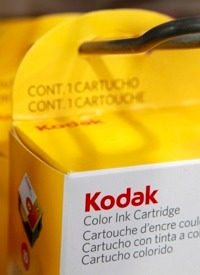
In the mid-1990s the company had a virtual monopoly on photographic film that was enormously profitable and may be have been part of the cause of its failure to adapt to changes in the marketplace and in consumers’ tastes. Ironically, its success in developing the first digital camera in 1975 was heralded by its developer, Steve Sasson, as an invention that could “substantially impact the way pictures will be taken in the future.” There was no way he could have known then just how close to the mark he was, or the negative impact such an invention would have on his own company. He called it “film-less photography” which took a “year of piecing together a bunch of new technology that ran off 16 nickel-cadmium batteries, an unstable imaging array, and some parts stolen from a digital voltmeter.” It took 23 seconds to record an image to a cassette tape which was then placed in a reader that displayed it on a black-and-white TV set.
But the company’s highly profitable dependency upon its film business kept it from seeing the coming change, and it failed to adapt in time to save itself. As a blogger noted in feedback to The Atlantic’s article, “What Killed Kodak,”
While it’s easy to say that digital “killed” Kodak, the truth is that it was film — or rather the insane profit margin of film — that did in the company. Those huge profit margins covered up a lot of internal inefficiencies.
It also blinded the company to its imminent peril as digital photography took off, leaving Kodak in the impossible position of trying to play catch-up ball. It was late in developing its own digital cameras but managed briefly, in 2005, to sell nearly $6 billion worth, making it No. 1 in digital camera sales in the United States. By 2007 it had slipped to fourth, and by 2010 it was in seventh place behind more nimble players such as Canon, Sony, and Nikon.
In June 2005, Antonio Perez became Kodak’s Chairman and CEO and moved heroically to turn the company around. He removed most of the top staff people left over from the fading film business and replaced them with digital people. He himself came over from Hewlett-Packard where he had headed up their printer business. He slashed payrolls, closed film-making facilities, and put in place a new paradigm: selling expensive printers and cheap film, rather than cheap printers and expensive film (like HP). After the company made huge investments in the hundreds of millions of dollars, time just ran out. Kodak simply couldn’t build the necessary printer cartridge customer base quickly enough to overcome the slowdown in revenues from the photographic film side of the business.
Holding onto the bulk of its patents and nearly 35 percent of the high-end printer business may persuade the bankruptcy courts to give Kodak some breathing room. It will also allow the company to renege on some of its pension obligations and cut its overhead costs further.
There were fatal flaws in Kodak’s business model but none more devastating that failing to realize at least two things: that digital cameras became “commoditized” much more rapidly than Kodak expected, and that their own internal image as being in the film business, rather than in the “image” business, kept them from confronting their competition successfully in time to avoid failure.
Consumers built up Kodak to its preeminent position, and consumers left Kodak for better products made by its competitors. It lost its near-monopoly status not because of any anti-trust actions brought by the Federal Trade Commission, but because of natural action in the free market. As economist Mark Perry noted, “The rise and fall of Kodak is a great example of several economic principles including … ‘creative destruction, ‘market competition,’ ‘discipline of the market,’ … and the economic reality that even a firm with a dominant, near-monopoly status in the short run … will be unable to maintain that position in the long run.”
Kodak will likely emerge from its impending bankruptcy with its name still intact, but it will be a shadow of its former self: much smaller, much more focused on high-end commercial printing equipment, and severely chastened by the inevitable operation of the free market. The consumer is better off as well, enjoying the refinements developed by Kodak’s competitors since the digital camera was first developed by Kodak in 1975 but then ignored by the company until it was too late.
Photo: AP Images



